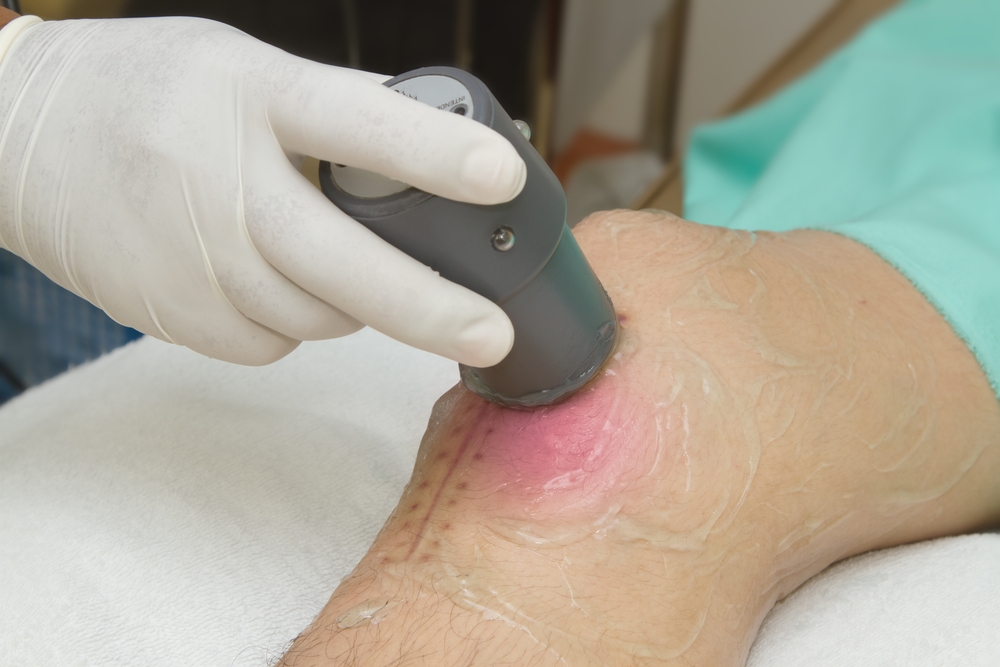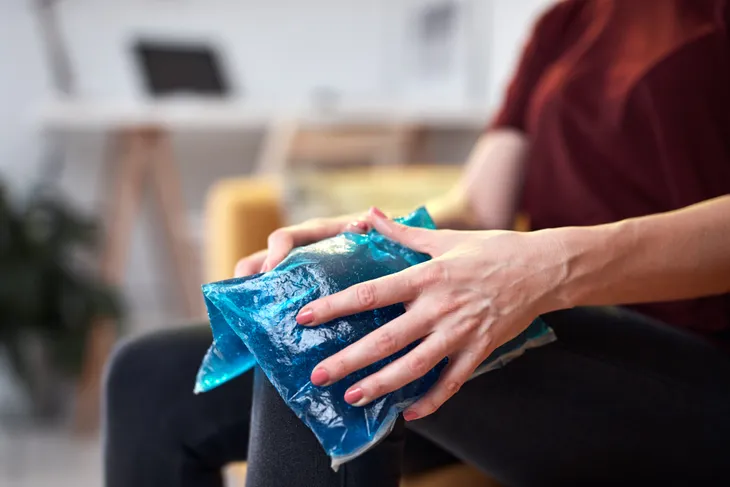Tendinitis is a type of injury that occurs with overuse. It results when a tendon, the thick cord that attaches the bone to the muscle, becomes inflammation or irritated due to an impact or injury. The damage occurs when the body is unable to rebuild the tendon with adequate rest.
Because tendonitis is most caused by repetitive stress—commonly from a sports injury or work stress—rest is the most important factor. However, the following ten treatment options have proven successful before considering surgery…
1. Acupuncture
Acupuncture is aimed at increasing the blood supply and blood circulation to the affected tendon, which in turn encourage the release of endorphins and serotonin (the body’s natural pain relievers). Acupuncture can reduce inflammation of the affected joint through needling not only the affected area, but other areas of the body that have been known to cause tendonitis. Oftentimes this can be adequate relief from pain associated with tendonitis, with no need for prescription painkillers.
Tendonitis can turn into a chronic occurrence if it isn’t treated, so it’s important to find a treatment to relieve the swelling and pain whenever you experience it. Many people get tendonitis in the hand, wrist and forearm, and even experience numbness and tingling in the affected area. While acupuncture is often a successful method to treat these symptoms, sometimes it is unable to help because of the cause of the problem. A licensed acupuncturist can evaluate your case and determine if they are able to help.
2. Physical Therapy
Physical therapy can help increase the range-of-motion, and reduce pain and inflammation affecting the tendon. Closely monitored physical therapy exercises can also strengthen the attaching muscle to provide better protection against greater tendon damage, as well as decrease the chance of it reoccurring. Stretching and strengthening exercises in the muscles around the affected area have been known to help relieve tendonitis symptoms. Physical therapy is a popular course of treatment because of how effective and preventative it can be.
Your physical therapist might do an ultrasound of the area they suspect to be inflamed and painful due to tendonitis. This test allows them to confirm the issue and look for other common problems like bursitis. Once there is a confirmed diagnosis, the physiotherapist will create a treatment plan to fix the affected tendon. Physiotherapy often integrates massage into the treatment plan, along with exercises and stretches. And some physiotherapists may also use laser or ultrasound therapy.
3. Cortisone Injections
If the symptoms of tendonitis are persistent, an injection of cortisone may be considered. Cortisone is a powerful anti-inflammatory medication, that’s injected directly to the site of inflammation – instead of as oral medication. This can be extremely helpful for situations that are not improved with rest or other treatments. Because cortisone shots offer immediate, short-term relief, a lot of people go back to their regular activities, including what caused the tendonitis in the first place. Doing so often results in recurrence of the tendon issues and the potential to increase the chance of chronic problems. If you get cortisone shots for tendonitis, be sure to finish the suggested resting period by your doctor.
Some health professionals don’t think tendonitis should be treated with cortisone shots, or at least not regularly. There are some concerns of these shots doing more harm than good in the end. Not all types of tendonitis can be addressed with cortisone injections, either. For example, Achilles tendonitis is rarely injected with cortisone because of concerns about possible rupture of the tendon.
4. Anti-Inflammatory Medications
Nonsteroidal anti-inflammatory medications (or NSAIDs) are often prescribed by a doctor as a type of over the counter pain relief (i.e., Ibuprofen or Motrin) for reducing tendon pain, swelling and inflammation. These medications can be administered orally (taken as a pill), or as a cream. Some people prefer using anti-inflammatory creams because of the immediate, soothing feeling when the cream is rubbed directly on the affected area. These medications should not taken for long periods of time, and you should check with your doctor before taking them if you have any current medical issues.
Depending on the type and severity of your tendonitis, anti-inflammatory medications may not work – it’s common for them to be helpful with pain management and inflammation in the early stages of tendonitis, but later on, it may not be so helpful. It’s important to note that while anti-inflammatory medications can be used to treat pain and early inflammation, they can’t be used as a preventative measure, so they should be used in combination with other treatments.
5. Massage Therapy
Massage therapy also has many benefits when it comes to lessening pain and encouraging blood flow to the affected tendon. Deep massage can also promote mobility and speed up the healing process. Massage therapy focuses on moving back and forth over the injured fibers that surround the affected tendon. A lot of athletes get tendonitis from repetitive, rigorous training and competitions. Medications are not nearly as effective when you are prone to chronic tendonitis, which is why treatments like massage therapy are often needed to provide more relief or even used as a preventative treatment.
While there are some massage techniques that you can use on yourself (if you can easily reach the inflamed tendon), it’s a good idea to see a registered massage therapist as well for the most effective treatment. There are many different massage techniques that target specific areas and tendons, and getting the best treatment for your situation will speed the healing process.
6. Electrotherapy
Electrotherapy is a long-used treatment when it comes to reducing inflammation, decreasing pain, promoting tissue repair, and increasing blood circulation, and eventually, range-of-motion in the joint. Nerve fibers are stimulated by the small electrical impulses from the electrotherapy machine. It decreases the pain because endorphins are released when the machine sends the electrical impulses. Electrotherapy can be used in both acute and chronic tendonitis cases, but usually early on when the tendonitis isn’t severe, and in combination with other treatments like physiotherapy, heating and icing.
The impulses go through pads that are stuck to the skin the affected area. While he electrical impulses don’t hurt, they may cause tingling sensations. There are several different forms of electrotherapy available, varying in intensity and frequency. Some are better for short-term relief and others for long-term. Your doctor will likely refer you to a specialist to perform the therapy based on the cause of tendonitis and severity.
7. Braces and Splints
Protecting the affected tendon will also provide quite a bit of relief and give it time to heal. And a wrist splint or knee brace can provide protection when performing activities or sports that demand effort from the joints in the affected area. Braces and splints are a common treatment for tendonitis, especially if it isn’t severe. Often just mobilizing the affected area can completely eliminate pain and inflammation. If you have tendonitis in your wrist, you may need to wear it throughout the work day if your job entails sitting at a desk and typing throughout the day.
It may even be beneficial to use both a wrist splint and wrist rest at your keyboard. Wrist rests remove the pressure and strain on your wrists from typing. Using a brace or splint is most effective when you catch the problem early on, before it gets to the point that it’s debilitating. Your doctor can help explain the different types of splints and braces, and recommend what’s best for you.
8. Ultrasound
Ultrasound technology is often utilized by physical therapists in order to increase joint circulation. The ultrasound machine sends sound waves and produce heat towards the affected joint to reduce pain, loosen tight muscles, and speed healing. They’re also extremely effective in reducing inflammation. Oftentimes you will feel immediate relief from an ultrasound session, which typically last for around 5 minutes. Ultrasound treatments are commonly used in the sports industry to treat a wide range of muscle and tendon issues, including tendonitis.
While ultrasound is a popular technique used around the world and many people have benefited from the treatment, there’s a lot of dispute in the medical profession about whether or not ultrasound technology actually helps repair injured tissue. There’s a lack of scientific proof about many of the claimed benefits, but health professionals continue to use it because of how often and well it provides relief for their patients. Some experts have seen patients experience faster relief from soft tissue injuries and a significant decrease in inflammation. If it works and your doctor sees no other risk to your health, why not use it?
9. Ice and Heat
A simple but important and fairly beneficial tendonitis treatment is using ice and heat. Alternating ice packs and heat packs to an injured joint will lesson inflammation (with ice) and increase circulation and loosen tightness (with heat). On top of this, ice can help numb the area and heat can provide general warm relief. It can be very soothing to employ this treatment method, and is often effective in the early stages of tendonitis before it gets too severe.
Ice and heat are usually used in combination with other treatment techniques, after a treatment session. Sometimes treatments can cause temporary flare ups, and your doctor or other health professional administering the treatment will suggest you go home and use heat, ice, or both. For example, certain physical therapy stretches, exercises and manipulations may cause the inflammation or pain to increase temporarily. But if you experience these flare ups, don’t give up on your treatments. Just make sure you inform the physical therapist of what happened so they can keep track of it in your file.
10. Cryotherapy
Cryotherapy (or freezing damaged tissue using nitrogen or carbon dioxide) is a method used to eliminate injured tissue from the actual joint and surrounding the tendon in order to reduce pain and restore full range of motion. It has been proven to be an extremely effective way to relieve pain associated with tendonitis. As previously mentioned, with such a wide range of treatment options for tendonitis sufferers, a lot of cases require more than one type of treatment to relieve symptoms and hopefully prevent tendonitis from becoming a chronic condition.
Cryotherapy is just one of many treatments to help you heal. It’s also important to note that you shouldn’t self diagnose what’s causing your swelling and pain – a lot of other joint, muscle and tissue conditions can mimic the symptoms of tendonitis. And as with most medical conditions, the earlier tendonitis is diagnosed the better. Don’t let your symptoms become severe before seeing your doctor.













